If you are an adventurous foodie, and a travel-lover, then this article is for you. Every travel-holic aspires to make a world trip at least once in their lifetime. Going to exotic places and experiencing exotic cultures seems like the world’s most exciting thing. However, exotic places come with exotic foods and food dishes, not all of which may be pleasant.
So if you are one of those people planning to go on a world trip some day, do proceed. Because here I have compiled a list of the top 10 weirdest foods from across the world that will make you cringe (and maybe gag):
Black pudding (Ireland, Britain)
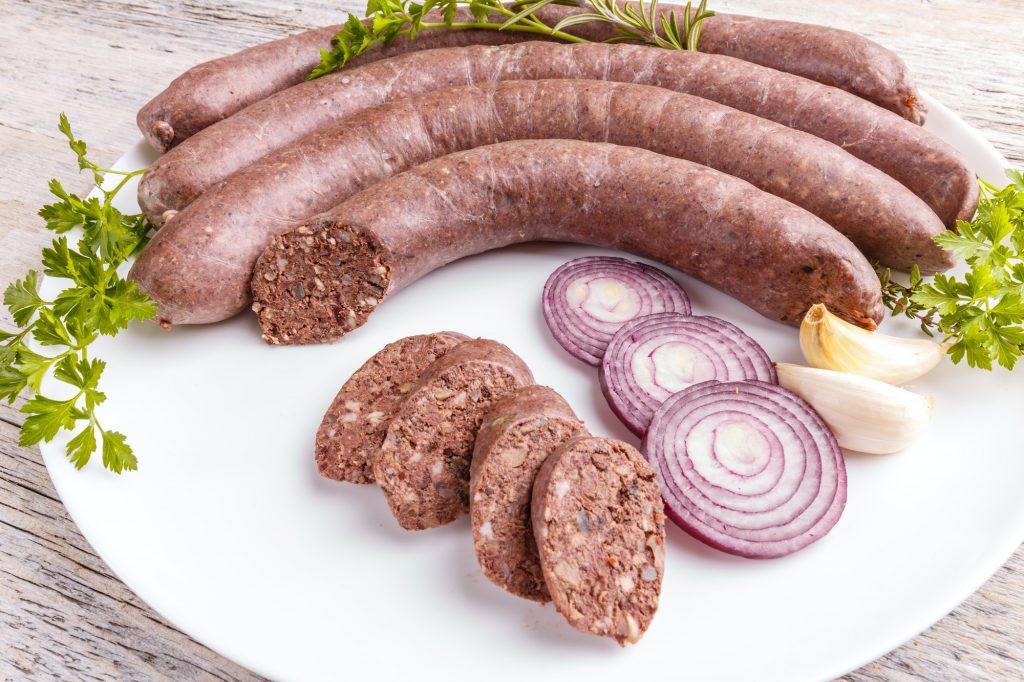
This extremely popular dish (deemed a “superfood” by many) is actually the blood of a pig mixed with oatmeal and some fat. All these are mixed and congealed together, then made solid after cooling and cut into pieces.
Black pudding is an extremely popular dish among the British and the Irish. It is high in protein, zinc, and iron, but also high in fat and salt. This food is only weird if you don’t know what it is made of. So if blood makes you squeamish and you are having breakfast in Britain, beware of this pudding.
Hakarl (Iceland)
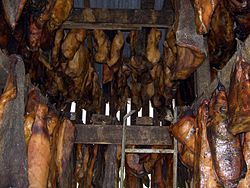
Source: Wikipedia
Hakarl, in plain English, means fermented shark. It doesn’t sound that bad considering the types of animal meat are consumed around the world. However, you may wince a little after knowing that the meat is toxic and only eaten after letting rot for 2-4 months.
Earlier the meat was fermented in a shallow hole dug in gravelly sand, and hung out to dry for another few months afterward. After this process, the brown crust that develops on the meat is removed, and the meat is cut into pieces and served raw. You can now imagine the smell of this delicacy. But you can (if you dare to) find some comfort in the fact that it probably doesn’t taste as bad as it smells.
Century egg (China)

The dish is literally its name- a century egg, sometimes also called a thousand-year egg. More precisely, this is an egg that has been preserved for several months in a mixture of clay, salt, and quicklime. In this process, the yolk becomes a cringey dark green and the white turns brown, and the egg acquires a strong flavor.
Generally, duck, chicken, or quail eggs are used for the purpose. The clay preserves the egg, while the salt catalyzes chemical reactions giving it more flavor (and color). Century eggs are generally eaten peeled and cut into pieces, served as a side dish or as a delicacy. You may need to hold your breath to be able to eat it, so beware.
Wasp crackers (Japan)

Yes, the food is exactly what the heading implies. These crackers look like any typical Japanese rice cracker (called senbei), except that they have wasps embedded in them. The wasps are first boiled in water, then dried and added to the rice cracker mixture. Wasp crackers are quite popular as a snack in some parts of Japan and highly commended for their protein content. (Yes, wasps are really high in protein).
These crackers smell like fish food, but actually taste pretty good, with the cracker taste intact and the wasps tasting like burnt raisins. So you can eat insect body parts without feeling squeamish, go ahead and give them a try!
Bird nest soup (China)
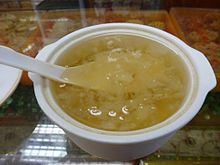
Source: Wikipedia
You may have heard of bird soup, but soup made of a birds’ nest? Not much heard of. No no, this soup is not made of a nest of twigs and leaves. This Chinese delicacy uses nests made out of a bird’s saliva that is dried and hardened.
The swiftlet bird found in China builds its nest out of saliva. These gooey nests are plucked from the sides of the caves where these birds are found and then served boiled, seasoned with herbs and spices. Initially, the nests were just plucked at random, but now swiftlet nests are actually harvested primarily for human consumption.
Birds nest soup is a highly relished delicacy in many countries of South-east Asia, especially China and the Philippines. This food is extremely rare, extremely valuable, surprisingly delicious, and hence highly sought after.
Rocky mountain oysters (West Canada)
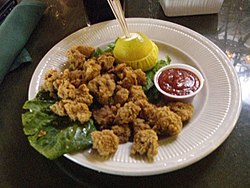
Source: Wikipedia
Don’t be fooled by the name, these aren’t actually oysters. Rocky mountain oysters are actually the testicles of cows and bulls that have been deep fried. This delicacy is especially popular in the farming areas of Western Canada where castration of cattle is prevalent. These deep-fried testicles are served as an appetizer in restaurants, or as a street food in festivals and carnivals.
They are named so bizarrely because of their taste and shape (like oysters), and the region they are most popular in (near the Rocky Mountains). However, considering how weird all the other dishes are on this list, this doesn’t really qualify as weird.
Balut (Philippines, Vietnam)
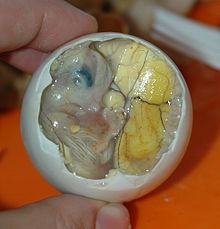
Source: Wikipedia
Balut is actually the embryo of a duck that is boiled and eaten right out of the shell. This dish is a highly popular street food in South-east Asian countries like the Philippines, Thailand, and Vietnam.
The fertilized egg is incubated for 2-3 weeks by burying it in the sand, and then boiled. After this, the shells are peeled to show the partially developed embryo inside a slimy yolk. This egg is now seasoned with chili, vinegar, and garlic, and served with beer.
The dish may sound unappetizing but is actually quite delicious and has high nutritional value. Some even consider it to be an aphrodisiac. But now, Balut might be a tasty dish, but it is definitely a powerful example of cruelty towards animals.
Fugu (Japan)

Fugu is basically a blowfish that is cut into paper-thin slices and served raw, seasoned with herbs and spices. It is one of the most expensive gourmet dishes in Japan. Fugu is prepared by peeling the skin off the dead blowfish, then gutting it by cutting out its intestines, ovaries and the liver. After this, it is either boiled or cut into pieces and served raw.
This Japanese dish is an exclusive delicacy primarily because it is extremely dangerous. The blowfish fugu contains a poison tetrodotoxin, which is almost 1200 times more toxic than cyanide. If the chef makes the slightest mistake, one can suffer immediate death post-consumption. Because of this risk, Fugu is only prepared by licensed chefs which make it a highly expensive and luxurious food dish.
Sannakji (Korea)
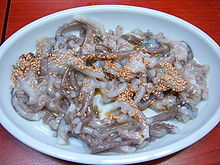
Sannakji is a Korean delicacy of raw octopuses. Yes, I am not joking. This Korean delicacy comprises the live tentacles of a baby octopus seasoned with sesame oil and red chili paste. Apparently, these tentacles are still very much alive and wriggling on the plates when served to the customers. In fact, some Koreans even eat the entire octopus (tentacles plus body) raw, wrapping it around their chopsticks.
This food is also dangerous because those “live” tentacles have suction cups on it. If you aren’t careful enough and don’t chew properly, these suction cups may choke you and cause instant death. And this is not a joke either- around six to seven people die everyday choking on this delicacy. Well, all hail the brave Koreans!
Raw blood soup (Thailand, Vietnam)
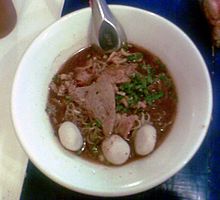
This soup is made with the blood of a raw pig. The soup is entirely made of raw ingredients and without any cooking processes whatsoever. You basically ARE drinking the blood of a pig, which makes you a swine vampire (LOL). It is not the end, however. There are more ingredients that go into a traditional Thai blood soup that will make you want to throw up.
This soup is a concoction of raw blood (cleansed with lemongrass and holy basil) and an impressive number of spices like chili flakes and cumin, along with some condensed milk. The soup is finally garnished with fried chilies, rice noodles, and wasp larvae. Then it is served with slices of raw pig’s kidney and raw pig’s neck fat.
The dish in itself is actually quite delicious, with the consistency of full-cream milk. But I don’t think there are a lot of people who are fine with the idea of stomaching raw pork blood with live wasp larvae.
Now if you plan to go globe-trotting and visit the above places, beware. You will definitely encounter these foods, so hold your breath and clench your stomach! We wish you all the best!


